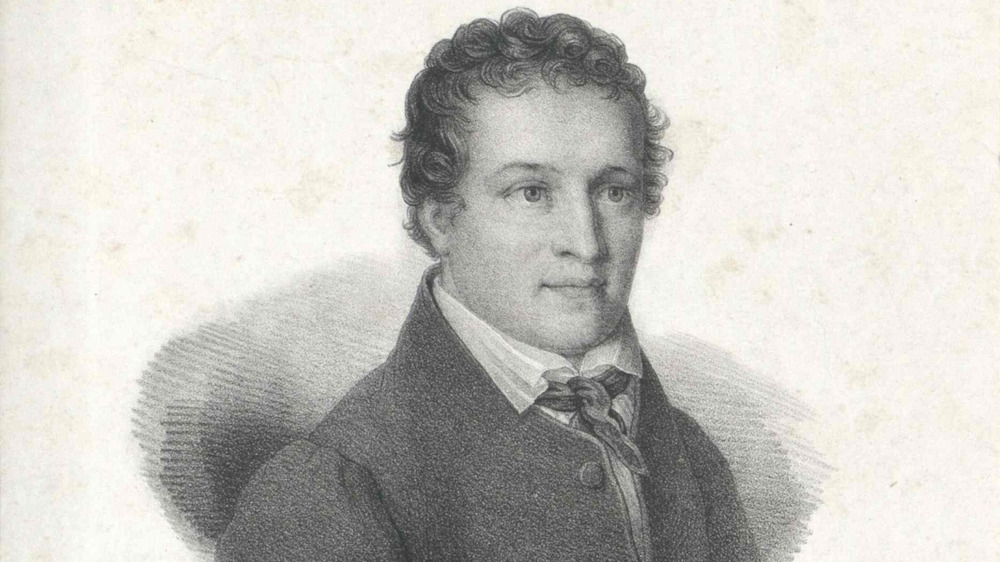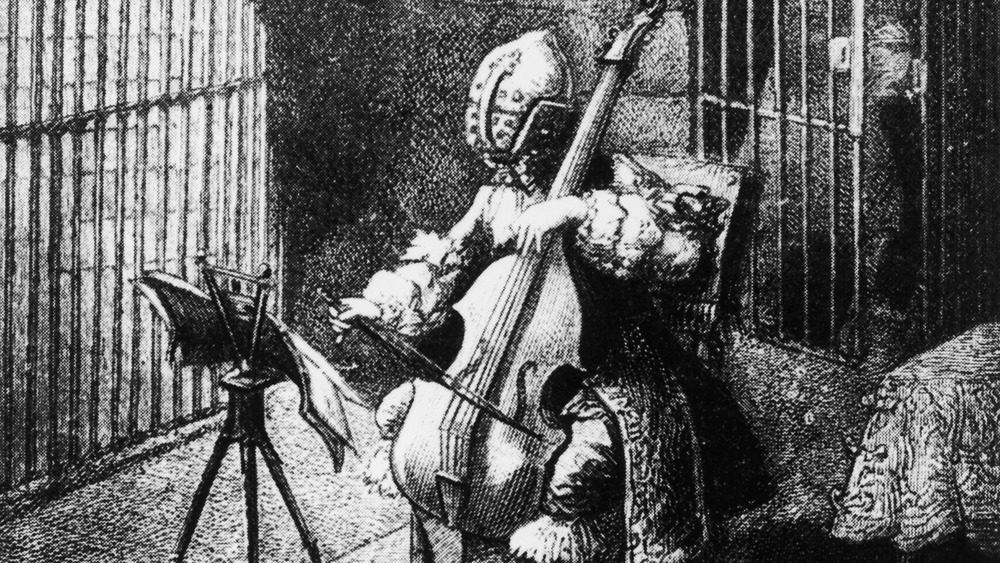Real-Life Unsolved Mysteries That Sound Fictional
We may receive a commission on purchases made from links.
Good shows and movies can sell a story no matter how crazy it is. But there are plenty of times when you'll find yourself watching TV and thinking that it all sounds too unlikely to pass for even a fictionalized version of the truth. Amazingly, sometimes life tells those stories too — strange tales that'll have you calling out the writer behind the scenes for expecting you to believe that. But you should believe, because it's all true.
The life and times of Kaspar Hauser
If there's any life story that deserves to be made into a period piece on Netflix, it's the story of Kaspar Hauser. LiveScience took a crack at separating fact from fiction, and they came up with some pretty bizarre stuff.
We know he was found wandering in a town square in Nuremberg on May 26, 1828. When he was questioned, he knew strangely little — apart from his name, Kaspar Hauser. Later, when curiosity about the stranger kicked into high gear, he would claim that he had been kept in a dark room by people he never saw, which sort of explained why he had no manners to speak of and a preference for bread and water. It only gets weirder, because over the next few years there were at least three attempts on his life. No one ever saw any attackers, and Hauser was thought to be alone when they happened. In 1833, he was killed in one of these mysterious attacks.
There are tons of theories about just who he was and what really happened to him, and they range from the possibility that he was a complete fraud to the theory that he had mental and emotional issues stemming from childhood abuse. One of the stranger theories is that he was an illegitimate claimant to the throne and someone wanted him out of the way... but we'll likely never really know.
The identity of the Man in the Iron Mask
You probably know the story of the Man in the Iron Mask. The version you may remember was written by Alexandre Dumas in the 19th century. But while the book was fiction, the story also had a basis in reality.
According to The Times Literary Supplement, the real man was every bit the mystery as his fictional counterpart. Benigne de Saint-Mars was one of the King's men put in charge of governing prisons. As Saint-Mars was transferred from prison to prison, a mysterious, unidentified prisoner stayed with him the whole time — allegedly masked (in iron, or in velvet, as some reports claimed) whenever he was in public. The mystery man died at the Bastile in 1703, and the name "Marchioli" was recorded in the death register. No one really believes the name was real, and attempts to figure out who the prisoner was have uncovered more than 50 different possibilities, ranging from a 12-year-old who punched the Dauphin to an illegitimate son of Charles II. We still don't know who it may have been.
The murders of Sture Bergwall/Thomas Quick
Here's a question for you: would you confess to being a serial killer who was responsible for a string of the most horrible murders you can imagine... when you weren't a killer? According to a GQ article, Sweden's Sture Bergwall did exactly that.
Bergwall was committed to a secure psychiatric hospital in 1991, when he took the name Thomas Quick (which he said was a combination of his mother's maiden name and his first victim, who he claimed he killed when he was 14). By 2001, he had been convicted of eight murders. At his trials there seemed to be no question that he was guilty. He knew grisly, horrible details, he could describe what had been done to bodies in graphic terms, and he confessed freely. Open and shut case, right?
After his eighth conviction, however, he stopped cooperating. He refused to say anything else, until he opened up in 2013 with a different kind of confession. Now going by the name Bergwall again, he admitted that not only had he never killed anyone, but that he had gotten most of his information by coercing it out of law enforcement and journalists. Why? Because when he sought help from a therapist for emotional issues they were bored with him, and he wanted to find something that would interest them — hence the murder confessions.
The Local out of Stockholm reported in 2010 that Bergwall had been acquitted of all the murders. But the revelations about his false confessions means that Sweden now has a whole string of unsolved killings.
Why you shouldn't take candy from strangers
You've heard the saying that you shouldn't take candy from strangers, and it's so overdone that it's a bit of a cliche. According to Harvard Library Collections blog The Shelf, the saying comes from the very real — and still unsolved — kidnapping case of Charley Ross.
The story was published in 1876 in Chrisian Ross' The Father's Story of Charley Ross. In June of 1874, a man in a wagon was handing out candy to kids in the Germantown area of Philadelphia. On July 1, Charley went missing, but his brother, Walter, said, "[...] why, he is all right; he is in the wagon." Once Walter provided a little more of the story, he revealed that Charley's abductors had earned their trust with candy, and when they offered to take the boys to a store to buy some firecrackers (this was 1874, after all), the boys didn't hesitate to go with them. Walter was eventually left by the side of the road to find his way home, and a manhunt for Charley began.
In 2013, a librarian stumbled across what the Smithsonian says are the first ransom notes ever sent in America — which happened to be ransom notes for Charley Ross. The kidnappers demanded $20,000 (about $400,000 in today's money) for the four-year-old's return. Over the next five months, Charley's family received 23 letters from the kidnappers and investigated more than 600 children who might have been Charley. He was never found.
Who was the Circleville Letter Writer... and what did he say?
It's the biggest trope in horror: the mysterious entity who seems to know everything about you. It really happened in Circleville, Ohio, and no one knows who was behind the secret-filled letters that started showing up in 1976.
Gizmodo took a look at what we know about the mysterious Circleville Letter Writer, and it's just enough to make you remember to close your curtains at night. The deadliest series of letters started with one that accused a woman named Mary Gillispie of having an affair with the school superintendent. Her husband, Ron, also got some letters, informing him of the alleged affair. Friends and family were questioned, and the letters stopped... but whoever was behind the accusations apparently wasn't done yet. Ron got a phone call on August 17, 1977, and it made him angry. He grabbed his gun and left the house in a rage. He died that day, found after apparently driving into a tree... and, ominously, firing his gun. No one knows who was on the other end of the phone, what was said, or what led to his death.
Mary's brother-in-law, Paul Freshour, was ultimately arrested for the whole mess, but handwriting tests and other evidence proved inconclusive. Despite that, Freshour was still found guilty and served a 10-year prison sentence, during which time he received his own cryptic letter. He maintained his innocence until his death in 2012 — and still, no one knows the whole truth about where the letters came from or how the writer knew so many small-town secrets.
The murders of Mary Ashford and Barbara Forrest
The Birmingham Mail tells a strange pair of stories over 150 years apart, both set in Pype Hayes Park, Birmingham, England. On the evening of May 27 in 1817, 20-year-old Mary Ashford left a local dance and headed home around midnight. A few hours later, a man on his way to work cut through the park and found her body. It wasn't long before officials arrested 25-year-old Abraham Thornton, who had been seen with her not long before her murder. He pleaded not guilty and was acquitted, then fled the area to start a new life away from the scene of his murder trial.
Fast forward to 1974, when 20-year-old Barbara Forrest was returning home from celebrating the May Bank Holiday with her boyfriend. Her body was found on June 4, also in Pype Hayes Park (only 500 yards from her home) — and the other similarities are eerie. She, too, was last seen alive on May 27, the two women had been out celebrating the same holiday (Whit Monday), and while Abraham Thornton was put on trial for the first murder, it was Michael Thornton who was the leading suspect in the second one. Like Abraham, Michael was acquitted at his murder trial. Neither case has been solved.
The museum's surprise skull
Let's be honest here: dioramas in museums are the creepy stuff of nightmares. No schoolchild in the history of school children actually likes them, with their lifeless poses and their staring, dead eyes. In 2017, Pittsburgh's Tribune-Review reported on a discovery from the Carnegie Museum of Natural History that proves just how disturbing they can be.
The museum has an exhibit called "Lion Attacking a Dromedary," which you can see above. As disturbing as the display is, it's even more creeptastic that the museum has known for a long time that the camel-rider has some disturbingly real teeth. It was only when they dismantled the display for restoration that they found the mannequin didn't just have real teeth. It had a real human skull.
We have so many questions... and so does the Carnegie Museum. The diorama is actually surprisingly old, and it was first displayed in Paris in 1867. It was eventually bought by Andrew Carnegie and ended up in the museum that bears his name, but no one knows where the skull came from. We do know that the whole thing was made by the Verreaux brothers (who were known to have created at least one other taxidermied person), and unfortunately, they were exceedingly bad record-keepers. It's possible that they might have just swiped a skull from the Paris Catacombs, but the original owner of the incredibly life-like face remains a mystery.
The Isdal Woman
She's called the Isdal Woman because no one knows her real name, and her burnt body was recovered from Norway's Isdalen valley on November 29, 1970. Her jewelry and her watch had been set out beside her, labels were cut off her clothes, and investigators likened the appearance of the crime scene to something ritualistic. The BBC followed the same set of clues investigators did — and it just made things weirder.
The first thing they found were her suitcases, left at the lost luggage department of a nearby railway station. The cases contained wigs, money from several different countries, eczema cream with the name scraped off the prescription label, and a coded message. The message was eventually decoded, and it was revealed to be a list of all the places she traveled to before she was killed. Police managed to track her movements across Norway, finding she had staying at a series of hotels under at least seven different aliases. Autopsy results revealed that she had been alive when she was set on fire, and that she had between 50 and 70 sleeping pills in her system.
Rumors suggested that she was a spy of some sort — Russian and Israeli agents were operating in Norway at the time — but there was never any proof. With no other leads, the case was closed in 1971. But since DNA and tissue samples were saved, it's possible that authorities might someday identify the Isdal Woman. That day hasn't come yet, though.
What was really going on with Emilie Sagee?
Emilie Sagee was a rather well-liked teacher living and working in a French-language school in Latvia in 1845. Well, she was well-liked, sure. But her doppelganger? Not so much. That's what one of her former students told the writer Robert Dale Owen, and it's an unsettling tale re-told by Thought Co.
According to the testimony of Julie von Guldenstubbe, Sagee would occasionally find herself visited by her own doppelganger. It happened while she was doing pretty everyday stuff like eating dinner and writing lessons, but sometimes the double would be seen in a completely different part of the school from the real Sagee. In one episode, 42 students sat in the school hall and worked on embroidery while the real Sagee picked flowers outside their window. They could see the real Sagee... as well as the doppelganger, who sat in a chair alongside her students.
Accounts compiled by EsoterX suggest that this kind of thing happened a lot to Sagee, and that she was fired from at least 20 different schools because of the phenomenon. Even though there's a huge number of witnesses that saw her doppelganger — at times even standing or sitting right next to her — poor Sagee herself never did. Those who witnessed the incidents said she seemed to feel fatigued whenever her doppelganger appeared, regaining her strength when the double vanished. Not only do we not know what was really going on with Emilie Sagee, but we unfortunately have no idea how to get a doppelganger of our own.
The Lead Masks Case
There are so many crime dramas on television that it seems like they're all just trying to outdo each other in terms of the craziest body discovery. But they don't have anything on the bodies of Miguel Jose Viana and Manoel Pereira da Cruz, two men that Mental Floss describes as Brazilian electrical engineers who went out in the most spectacularly bizarre way possible.
When they were found on August 20,1966, they were laying side-by-side, were dressed in suits and waterproof coats, and were wearing lead masks. They had a pair of towels with them (because you should always know where your towel is), an empty water bottle, and a notebook that contained an entry that translated to, "16:30 be at agreed place, 18:30 swallow capsules, after effect protect metals wait for mask signal."
And, that's pretty much it. No one has the foggiest idea what the story behind their mysterious deaths is, but we're pretty sure it must be amazing. Since no toxicology reports were ever done, no one even knows what the two took, if anything. As for what they were waiting for, and those metals that needed protecting? No clue there, either.
Who put Bella in the wych elm?
In 1943, four boys were hunting in Birmingham when they made a grisly discovery: the skeletal remains of a woman, lodged inside a hollow tree. Her hand and shin bones were buried nearby, dental records didn't match anything on file, and the case went cold pretty fast. She may have been forgotten about, but The Independent reports that graffiti started popping up around the area, asking, "Who put Bella in the wych elm?"
There were plenty of theories as to who Bella was, and in the 1950s people speculated that the murder had something to do with witchcraft. In 1953, a mysterious informant claimed something different: that the woman had been killed by a German spy ring that had set up shop in the British Midlands. Far-fetched crazy talk, right? Maybe not.
The theory — which is supported by declassified documents from MI5 — says that a German actress and cabaret singer named Clara Bauerle was the lover and partner of a Gestapo agent named Josef Jakobs. Jakobs was arrested after parachuting into Cambridgeshire in 1941, and told British intelligence that Bauerle was also connected to the upper echelons of the Nazi party. Photographs of them together proved they knew each other, and the up-and-coming actress disappeared after 1941. Was she recruited too, only to meet a grisly end? Jakobs — who was the last person to be executed at the Tower of London — was definitely real, so is it possible that the mysterious remains are from a Nazi spy? Sure is!
The strange, dark journey of LeRoy Carter's head
In 1981, law enforcement found the body of a man named LeRoy Carter Jr. in San Francisco's Golden Gate Park... but just his body. Carter's head was missing, and pieces of a chicken had been partially stuffed inside the body.
Enter Sandi Gallant, a special intelligence officer who was involved in the investigation at the Jonestown Massacre in Guyana. According to 13th Floor, Gallant was something of an expert in the realm of crimes committed with an eye toward black magic, the occult, and various types of witchcraft and spiritualism. Clearly, this was right up her alley. The LA Times reported that she guessed the crime scene had something to do with Santeria, and she put together a profile that included practitioners spending the next 21 days using parts of the man's head to cook up a ritual brew, then another 21 days of sleeping near the head. She also predicted that on day 42, the head would be returned to the scene of the crime.
And it was, showing up in the weeds near Alvord Lake exactly 42 days after the murder. No one saw whoever dropped the head back off on the scene, and the case went cold — but Gallant says that it was something of a wake-up call that dark stuff like this was actually possible.
What was Diane Schuler thinking?
On July 26, 2009, Diane Schuler piled her two children and three nieces into a minivan, got in the driver's seat, and drove for 1.7 miles the wrong way down Taconic State Parkway. She collided head-on with an SUV containing three people. Everyone died, with the exception of Schuler's 5-year-old son, who was left with two broken arms, a broken leg, and no memory of the accident.
According to New York Magazine, Schuler's blood alcohol level was 0.19%, which is more than double the legal limit and the equivalent of around 10 shots of vodka. Police say there was also evidence she had been smoking marijuana. But Schuler's family says the behavior was totally out of character for her. She was responsible, she wasn't a heavy drinker, and she was a caring mother. And she seemed to be completely fine an hour or two before the accident, when she spoke to her sister-in-law on her cellphone.
Schuler's family thinks there was something else behind her sudden drinking binge and reckless behavior. "Something medically had to have happened," her husband told New York Magazine. Maybe she'd had a stroke, and it had impaired her judgement, maybe it was something else. If Schuler was an alcoholic, it's unclear why her whole family had never noticed it. If she wasn't, that makes her behavior even more bizarre. But without anyone left who can say what happened between the phone call and the accident, this mystery probably won't ever be solved.
Three boys lost in a cave (maybe?)
The '60s were a much more innocent time, when kids could run around their neighborhoods chasing toads and climbing into dangerous unexplored caves and all their parents ever said was, "Make sure you're home for supper." Billy and Joey Hoag and their friend Craig Dowell were living every boy's dream. Their parents warned them against playing in caves, but the Hoag brothers were two of 11 siblings and let's face it, most normal parents only have four eyes between them.
In May 1967, the trio left home to explore caves in Hannibal, Missouri. A construction company was blasting parts of the hillside, which exposed holes that led to passageways into the caves. But the boys did not come home for supper, or ever again, and no one has any idea what happened to them.
Fox News describes the cave they were headed for as "sprawling," which means they could have become lost and it is conceivable that their remains were somehow missed during the search. But the search included FBI agents and professional spelunkers, so that explanation seems unlikely. One of the boys' sisters said she believed the trio went into the construction holes and were accidentally buried by workers. But 50 years later, the only trace that's ever been uncovered is a sock, which may or may not have been Craig's and which may or may not have had blood on it. Their bodies have never been found.
Who killed the Jeff Davis 8?
In a perfect world the police would never do anything bad and the bad guy would always be brought to justice, but we don't live in a perfect world unless your idea of a perfect world is a cop show from the '80s, and even then it would be a whitewashed, not-very-realistic perfect world with a super-lame soundtrack.
The Jeff Davis 8 was a series of murders that happened between 2005 and 2009. According to Rolling Stone, eight women in total turned up murdered. All of them were from "the poor side of town," all of them had criminal records and were supporting various nefarious habits with sex work, and all of them had side jobs as police snitches.
The police blamed the murders on a serial killer, but the investigative journalist who wrote the book Murder in the Bayou discovered that many of the victims had physical relationships with police officers and that much of the evidence appeared to have been tampered with or destroyed. People who protested were fired. And many of the victims had witnessed the murders of previous victims, only to be murdered themselves.
So was it a serial killer, with the added complication of serious police incompetence, or were the police somehow involved? If it was the former, we're not ever likely to get answers about the Jeff Davis 8. If it was the latter, well, same. Not much hope for a perfect Scooby Doo ending either way.
The Baroness of where?
This weird story begins in the 1930s, when a German doctor named Friedrich Ritter moved to the Galapagos islands with his lover. According to ThoughtCo, a few years later the couple were joined by a German family called the Wittmers, and then not long after that an Austrian named Eloise Wehrborn de Wagner-Bosquet showed up with her two lovers and a servant and all hell broke loose. Eloise called herself "The Baroness," set up a homestead and told everyone she was going to build a grand hotel.
The arrival of the Baroness was pretty much exactly like when the Victorian house in your quiet neighborhood gets suddenly converted into a frathouse. Eloise took over the neighborhood, anointed herself "Queen" (literally), and didn't get along with anyone. Everyone started fighting, someone shot someone else's donkey, and general pandemonium ensued. And then on March 27, 1934, the Baroness and one of her two lovers disappeared.
The Wittmers said the Baroness had gone to Tahiti on a yacht, but the pair never made it to Tahiti, if there was ever a yacht at all. Then the Baroness' other lover disappeared — he left with a Norwegian fisherman en route to San Cristobal Island. Their mummified bodies were found on Marchena Island several months later, miles off-course from San Cristobal Island.
Decades after the disappearances, no one is closer to understanding what happened to the Baroness, her two lovers, and that one Norwegian guy.
Sorry, Discovery Channel, it was probably not a Yeti
In 1969, nine skiers were found dead in Russia's Ural Mountains. According to Snopes, the group was missing for weeks before their camp was finally located on a mountain named Kholat Syakhl (which means "Dead Mountain") where they'd wound up after getting sidetracked en route to Gora Otorten (which means "Don't Go There"). Cue dramatic music.
Investigators found the skiers outside their tent, some nearly a mile away, buried under 13 feet of snow. There were footprints that indicated some of them had been barefoot, some were wearing socks, and one was wearing a single shoe. Two bodies were dressed only in underwear, and five appeared to have frozen to death. The other four were crushed, and one of them was missing a tongue. And to make the story super-extra weird, there were traces of radiation on the bodies and their clothes. And then the Soviets classified the case and restricted access to the area for more than three years, so...
Discovery Channel programming has suggested the Dyatlov Pass incident was caused by a Yeti, because the Discovery Channel is all about educating us and giving us facts and stuff. Snopes, of course, hypothesizes that the group was killed by an avalanche and the missing tongue was just normal decomposition. But hey, we can still cling to the traces of radiation part of the story, anyway. Snopes that one, Snopes.














